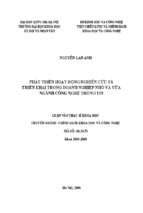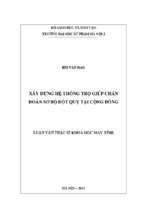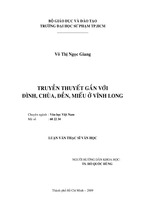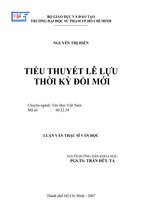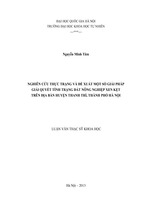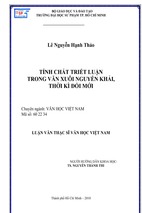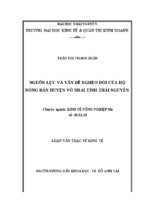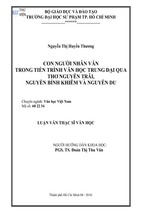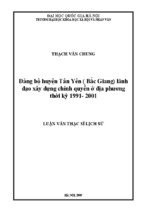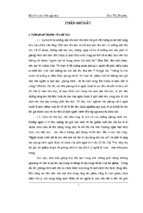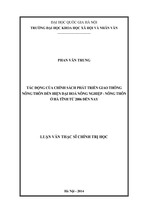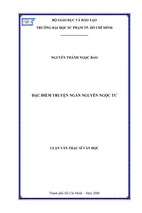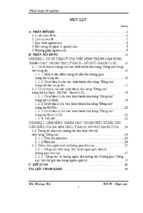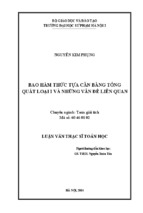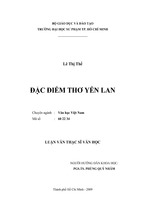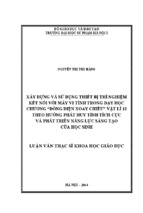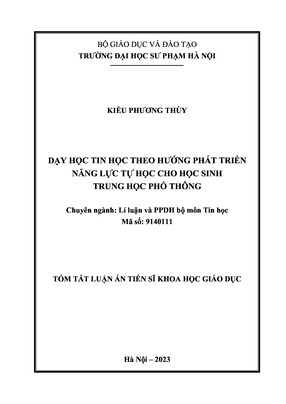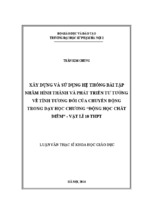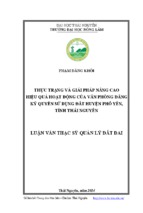VIETNAM NATIONAL UNIVERSITY, HANOI
UNIVERSITY OF SCIENCE
FACULTY OF MATHEMATICS, MECHANICS
AND INFORMATICS
Le Anh Tuan
STABILITY OF STOCHASTIC DYNAMIC EQUATIONS
ON TIME SCALES
THESIS FOR THE DEGREE OF
DOCTOR OF PHILOSOPHY IN MATHEMATICS
HANOI – 2018
VIETNAM NATIONAL UNIVERSITY, HANOI
UNIVERSITY OF SCIENCE
LE ANH TUAN
STABILITY OF STOCHASTIC DYNAMIC EQUATIONS
ON TIME SCALES
Speciality: Probability Theory and Mathematical Statistics
Speciality Code: 62.46.01.06
THESIS FOR THE DEGREE OF
DOCTOR OF PHYLOSOPHY IN MATHEMATICS
Supervisor: PROF. DR. NGUYEN HUU DU
HANOI – 2018
This work has been completed at VNU-University of Science under the
supervision of Prof. Dr. Nguyen Huu Du. I declare hereby that the results
presented in it are new and have never been used in any other thesis.
Author: Le Anh Tuan
Acknowledgments
First and foremost, I want to express my deep gratitude to Prof. Dr.
Nguyen Huu Du for accepting me as a PhD student and for his help and
advice while I was working on this thesis. He has always encouraged me in
my work and provided me with the freedom to elaborate my own ideas
I would like to express my special appreciation to Professor Dang Hung
Thang, Doctor Nguyen Thanh Dieu, other members of seminar at Department of Probability theory and mathematical statistics and all friends in
Professor Nguyen Huu Du’s group seminar for their valuable comments
and suggestions to my thesis.
I would like to thank the VNU of Science for providing me with such
an excellent study environment.
Furthermore, I would like to thank the leaders of Faculty of Fundamental Science, Hanoi University of Industry, the Dean board as well as to the
all my colleagues at Faculty of Fundamental Science for their encouragement and support throughout my PhD studies.
Finally, during my study, I always get the endless love and unconditional support from my family: my parents, my parents-in-law, my wife,
my little children and my dearest aunt. I would like to express my sincere
gratitude to all of them. Thank you all.
Abstract
The theory of analysis on time scales was introduced by S. Hilger in
1988 (see [26]) in order to unify the discrete and continuous analyses and
simultaneously to construct mathematical models of systems that are unevenly evolving over time, reflecting real models.
Since was born, the theory of analysis on time scales has received much
attentions from many research groups. One of most important problems in
analysis on time scales is to consider the quantity and quality of dynamic
equations such as the existence and uniqueness of solutions, numerical
methods for solving these solutions as well the stability theory...
However, so far, almost results related to the analysis on time scales are
mainly in deterministic analysis, i.e., there are no random factors involved
to dynamic equations. Thus, these results only describe models developed
in non-perturbed environmental conditions. Obviously, such these models
are not fitted to actual practice and we must take into account the random
factors that affect the environment. Therefore, the transfer of analytical
results studying determinate models on time scales to stochastic models is
an urgent need.
As far as we know, for the stochastic analysis on time scales, there
are not many significant results, especially, results related to the stability
of stochastic dynamic equations and stochastic dynamic delay equations.
Some results in this field can be referred to [13, 14, 40, 41, 44, 60, ...].
For the above reasons, we have chosen the doctoral thesis research topic
as ”Stability of stochastic dynamic equations on time scales”.
Thesis is concerned with the following issues:
• Studying the existence and uniqueness of solutions for ∇- stochastic
dynamic delay equations: giving the definition of stochastic dynamic
delay equations and the concept of solutions; proving theorems of existence and uniqueness of solutions; estimating the rate of the converi
gence in Picard approximation for the solutions. Proving theorem of
existence and uniqueness of solutions under locally Lipschitz condition
and estimating moments of solutions for stochastic dynamic equations
on time scales.
• Studying the stability of ∇-stochastic dynamic equations and ∇-stochastic
dynamic delay equations on time scale T by using methods of Lyapunov functions.
It is known that the theory of stochastic calculus is one of difficult
topics in the probability theory since it relates to many basic knowledges
like Brownian motions, Markov process and martingale theory. Therefore,
the theory of stochastic analysis on time scales is much more difficult
because the structure of time scales is divert. That causes very complicated
calculations when we carry out familiar results from stochastic calculus to
similar one on time scales. Besides, some estimates of stochastic calculus
for stochastic calculus on R are not automatically valid on an arbitrary
time scale. Therefore, it requires to reformulate these estimates and to
find new suitable techniques to approach the problem.
ii
List of Notations
A
Defined on the set C 1,2 (Ta × Rd ; R), is called generator;
B
Class of Borel sets in R;
Crd
Set of rd-continuous functions f : T −→ R ;
Cld
Set of ld-continuous functions f : T −→ R ;
C 1,2 (Ta × Rd ; R) Family of all functions V (t, x) defined on Ta × Rd
such that they are continuously ∇−differentiable in t
and twice continuously differentiable in x;
Ft+
= ∩s>t Fρ(s) ;
(Ω, F, P, {Ft }t∈Ta )Stochastic basis;
ft− = f (t−)
= limσ(s)↑t f (s);
I1
= {t : t is left-scattered};
I2
= {t : t is right-scattered};
I
= I1 ∪ I2 ;
Kt
bt
K
Density of hM it ;
cit ;
Density of hM
L2 (M )
Space of all real - valued, predictable processes
φ = {φt }t∈Ta satisfying
R
kφk2t,M = E (a,t] |φτ |2 ∇hM iτ < ∞ for all t ∈ Ta ;
L2 ((a, b]; M )
Restriction of L2 (M ) on (a, b];
L1 ((a, T ]; Rd )
Set of all Ft −adapted process φt satisfying
RT
a kφt k∇t < ∞;
Lloc
1 (Ta , R)
Family of real valued, Ft −adapted processes {f (t)}t∈Ta
RT
satisfying a |f (τ )|∇τ < +∞ a.s. for every T ∈ Ta ;
d
Lloc
1 (Tt0 ; R )
Set of functions, valued in Rd , Ft -adapted such that
RT
t0 f (τ )∇τ < +∞ for all T ∈ Ta ;
d
Lloc
2 (Tt0 ; R , M )
Set of functions, valued in Rd , Ft -adapted such that
RT
E t0 h2 (τ )∇hM iτ < +∞) ∀ T ∈ Tt0 ;
LV
= V ∇ + AV ;
Mloc
2
Set of the locally square-integrable Ft − martingales;
Mr2
Subspace of the space M2 consisting of martingales
with continuous characteristics;
hM i
Characteristic of the martingale M ;
iii
P
�
Ms − Mρ(s) ;
ct
M
= Mt −
Rn
n− dimensional Euclidean space;
R, Z, N, N0
Real numbers, the integers, the natural numbers,
s∈(a,t]
and the nonnegative integers;
R
R
Set of all regressive and rd-continuous functions f ;
+
T
Ta
kT
k
T
Set of positive regressive element of R(T, R);
Time scale;
={x ∈ T : x > a}, a ∈ T;
T \ {M } if T has a right-scattered minimum M
min
min
=
T
otherwise;
T \ {M } if T has a left-scattered maximum M
max
max
=
T
otherwise;
ρ(t)
Backward operator;
σ(t)
Forward operator;
µ(t)
= σ(t) − t (Forward graininess);
ν(t)
bt
Ψ
= t − ρ(t) (Backward graininess);
ct ;
Density of jumps of M
[a, b]
= {t ∈ T : a 6 t 6 b};
iv
Contents
Page
Abstract
i
List of Notations
iii
Introduction
Chapter 1
1
Preliminaries
12
1.1
Survey on analysis on time scale . . . . . . . . . . . . . . . . 12
1.2
Differentiation . . . . . . . . . . . . . . . . . . . . . . . . . . 15
1.2.1. Continuous functions . . . . . . . . . . . . . . . . . . 15
1.2.2. Nabla derivative . . . . . . . . . . . . . . . . . . . . . 16
1.2.3. Lesbesgue ∇− integral . . . . . . . . . . . . . . . . . 18
1.2.4. Exponential function . . . . . . . . . . . . . . . . . . 21
1.3
1.4
Stochastic processes on time scales . . . . . . . . . . . . . . 23
1.3.1.
Basic notations of probability theory . . . . . . . . . 23
1.3.2.
Stochastic processes on time scales . . . . . . . . . . 23
1.3.3.
Martingales . . . . . . . . . . . . . . . . . . . . . . . 25
∇−stochastic integral . . . . . . . . . . . . . . . . . . . . . . 27
1.4.1. ∇−stochastic integral with respect to square integrable martingale . . . . . . . . . . . . . . . . . . . . 27
v
1.4.2. ∇−stochastic integral with respect to locally square
integrable martingale . . . . . . . . . . . . . . . . . . 30
1.4.3. ∇−stochastic integral with respect to semimartingale 31
1.5
1.6
Itô’s formula . . . . . . . . . . . . . . . . . . . . . . . . . . . 32
1.5.1.
Quadratic co-variation . . . . . . . . . . . . . . . . . 32
1.5.2.
Itô’s formula . . . . . . . . . . . . . . . . . . . . . . 33
Martingale problem . . . . . . . . . . . . . . . . . . . . . . . 35
1.6.1. Counting processes for discontinuous martingales . . 35
1.6.2. Martingale problem formulation . . . . . . . . . . . . 38
Chapter 2
The stability of ∇-stochastic dynamic equations 40
2.1
Solutions of stochastic dynamic equations . . . . . . . . . . 41
2.2
Locally Lipschitz condition on existence and uniqueness of
solutions . . . . . . . . . . . . . . . . . . . . . . . . . . . . 42
2.3
Finiteness of moments . . . . . . . . . . . . . . . . . . . . . 47
2.4
Exponential p-stability of stochastic dynamic equations . . . 49
2.4.1. Sufficient condition . . . . . . . . . . . . . . . . . . . 50
2.4.2. Necessary condition . . . . . . . . . . . . . . . . . . . 51
2.5
Stochastic stability of stochastic dynamic equations . . . . . 64
2.5.1. Basic definitions . . . . . . . . . . . . . . . . . . . . . 64
2.5.2. Sufficient conditions . . . . . . . . . . . . . . . . . . 65
2.6
Almost sure exponential stability of stochastic dynamic equations . . . . . . . . . . . . . . . . . . . . . . . . . . . . . . . 71
2.7
Conclusion of Chapter 2 . . . . . . . . . . . . . . . . . . . . 74
Chapter 3
The stability of ∇−stochastic dynamic delay
equations
3.1
76
∇-stochastic dynamic delay equations . . . . . . . . . . . . . 77
3.1.1. ∇-stochastic dynamic delay equations . . . . . . . . . 77
3.1.2.
Solutions of stochastic dynamic delay equations . . . 78
vi
3.1.3.
Existence and uniqueness of solutions . . . . . . . . 78
3.1.4. Rate of the convergence . . . . . . . . . . . . . . . . 82
3.1.5. Locally Lipschitz condition on existence and uniqueness of solutions . . . . . . . . . . . . . . . . . . . . . 83
3.2
Exponential p-stability of stochastic dynamic delay equations 87
3.2.1. Sufficient condition . . . . . . . . . . . . . . . . . . . 87
3.2.2. Examples . . . . . . . . . . . . . . . . . . . . . . . . 89
3.3
Almost sure exponential stability of dynamic delay equations 92
3.4
Conclusion of Chapter 3 . . . . . . . . . . . . . . . . . . . . 94
Bibliography
96
Introduction
Stochastic calculus is one mathematical field studying mathematical
analytical calculations (integral, differential equations, continuity, stability
of solution...) towards the stochastic processes in order to build mathematical models for dynamic systems under effects of random factors. Consequently, stochastic analysis has many applications in biology, medicine,
physics, economy, social sciences..., and it attracts a lot of attention from
mathematicians. So far, stochastic analysis with continuous time and discrete time has been well studied. But in practice, most systems are not
fully functional and are not completely evenly spaced. Sometimes, observations intermingle both continuous and discrete times. For example, some
worms develop only during the summer but in the winter their growth is
interrupted. Therefore, in many cases, differential equations or difference
equations are insufficient to describe the required information of the model.
Hence, in recent years, one focuses on the so-called analysis on time scales.
1. Time scales
The theory of analysis on time scale, which was introduced by S. Hilger
in his PhD thesis [26], has been born in order to unify continuous and
discrete analysis. The results of analytical calculations on time scales
allow us to construct mathematical models of systems that are unevenly
evolving over time, reflecting real models.
The theoretical study of analysis on time scales has led to a number of
important applications, for example in the study of insect density, nervous
system, thermodynamic, quantum mechanics and disease model...
We know that there are many results of differential equations that are
made quite easily and naturally for difference equations. However, there
1
are easy results to show for differential equations, not simply for difference
equations and vice versa. Studying the dynamic equations on time scales
gives us a clear view to overcome this inconsistency between discontinuous
differential equations and discrete difference equations. In addition, it
is also avoided that a result may be proved twice, once for differential
equations and another for difference equations.
We can take the time scale as the set of real numbers R, the resulting
results will be similar to those in ordinary differential equations. If the time
scale is the set of integers Z, the resulting general result will be similar
to the result in the difference equation. However, time scales are rich in
structure, so the results are generalized and much better than the results
on the set of real numbers and on the set of integers. Therefore, the basic
characteristic of these time scales is unification and expanded. That is the
main reason there have been dozens of books and thousands of articles
dealing with the analysis on time scales [6, 7, 9, 16]. Many familiar results
in the continuous or discrete cases have been ”shifted” to time scales. For
example, on the study of the dynamical system on time scales, there are
very profound results on stability, oscillation, boundary value problems...
However, as we know, so far the results of the study on time scales
are mainly in deterministic analysis. Therefore, these results only describe
models developed in non-perturbed environmental conditions. Obviously,
the actual models are not so and we must take into account the random
factors that affect the environment. Hence, the transfer of the analytical
results on time scales of the determinate models to the stochastic model
is an urgent need.
2. Stochastic integral on time scales
2.1. Stochastic calculus with continuous time and discrete time
a. Brownian motion
In order to define stochastic integral, firstly we introduce Brownian
motion concept.
Brownian motion was firstly discovered by English physicist Robert
Brown in 1827, when he observed through the microscope, and he saw
2
the motion of suspended pollen particles in water is very chaotic. By experimenting with particles of inorganic matter, he eliminated the external
causes of the motion. However, the source of the motion has remained
unraveled.
In 1880, Thorvald Nicolai Thiele, a Danish astronomer [63], created the
Brownian motion model in mathematics when he analyzed the time series.
In 1905, Albert Einstein, the German physicist, described this phenomenon
under the name ”Brownian motion”. Although the Brown motion model
initially proposed by Thorvald Nicolai Thiele but the model was almost
unknown.
In 1923, N. Wiener used measurement theory to construct the Brownian
motion, and then demonstrated its unique existence.
Today, in recognition of his contribution, we call the Brownian motion
by Wiener process. In his work, N. Wiener pointed out that the trajectory
of Brown’s motion has unbounded variations. Thus, integration of Wiener
process can not be constructed in a conventional way as Lebesgue-Stieltjes
integral.
b. Martingales and semimartingales
In probability theory, a martingale is a stochastic process for which, at
a particular time in the realized sequence, the expectation of a future value
in the process is equal to the present observed value even given knowledge
of all prior observed values.
The concept of martingale in probability theory was introduced by
Paul Lévy in 1934, though he did not name them. The term ”martingale”
was introduced later by Ville (1939), who also extended the definition to
continuous martingales. Much of the original development of the theory
was done by Joseph Leo Doob among others. Part of the motivation for
that work was to show the impossibility of successful betting strategies.
A real valued process X is called a semimartingale if it can be decomposed as the sum of a local martingale and an adapted finite-variation
process. Semimartingales are good integrators, forming the largest class
of processes with respect to which the Itô integral and the Stratonovich
3
integral can be defined. The class of semimartingales is quite large (including, for example, all continuously differentiable processes, Brownian
motion and Poisson processes). Submartingales and supermartingales together represent a subset of the semimartingales.
c. Doob-Meyer expansion
In 1953, J. Doob [25] stated and demonstrated the Doob development
theorem for submartingale with discrete time and conjecture theorem for
submartingale with continuous time. These theorems were proved in 1962
and 1963 by P. A. Meyer [54]. So, the Doob development theorem is called
the Doob-Meyer expansion theorem.
d. Stochastic integral
On basis of the Brown motion. In 1944, K. Itô, a Japanese mathematician built the stochastic integral on the Wiener process [28]. Then
J.L. Doob [25] expanded the stochastic integral by the orthogonal increment process. Stochastic integral continues to be extended to the squareintegrable martingale by P. A. Meyer [54], by H. Kunita and S. Watanabe
[36].
In 1970, P. A. Meyer and C. Doléans-Dade [55] built a local squareintegrable martingale. Also in that year, C. Dellacherie and K. Bichteler
built stochastic integral by semimartingale. Today, stochastic integral
mentioned above is called Itô’s stochastic integral. For stochastic calculations with discrete time, the martingale transformations are considered
Itô’s stochastic integral.
e. Itô’s formula
The Itô’s formula for the Wiener process was developed by K. Itô [29]
in 1951 and is considered as a key tool in stochastic computing. In 1967,
H. Kunita and S. Watanabe [36] extended the Itô’s formula to square
integrable martingale. P. Meyer [53] extended Itô’s formula to martingale
with jump steps.
The Itô’s formula for semimartingales was developed in 1969 by H. P.
McKean in [51], expanded by P. A. Meyer and C. Doléans-Dade in [55].
4
For stochastic computing with discrete time, it was formulated in 2002
by D. Kannan and B. Zhan in [32]. Today, the application of the Itô’s formula in the study of the qualitative and quantitative properties of stochastic dynamic equations has become very familiar in stochastic analysis.
2.2. The first attempt on the stochastic calculus on time scales
As a natural way, we want to ”shift” and generalize the above notions
and results for stochastic calculus (Brownian motion, stochastic integral,
Doob-Mayer expansion...) with continuous or discrete times to time scales.
The stochastic analysis on time scales has just been born in some last
years. Since it is quite new subject, there are not too much in mathematical
literature. In [5], the authors developed the theory of Brownian motion
on time scales. Base on the concept of infinitesimal operator, they studied
Brownian motions valued in a time scale with continuous time. After, S.
Suman in his Ph.D. Dissertation [60] tried to defined ”stochastic integral
on time scales” but he just deals with time scales consisting only of isolated
points.
In [13], the authors N. H. Du and N. T. Dieu have done the first attempt
to study systematically stochastic calculus on the time scale. In that paper,
they have dealt with the Doob - Meyer decomposition theorem, stochastic
integration, Itô’s formula for stochastic processes indexed by a time scale.
When constructing a stochastic integration on a time scale, the most
difficulty we are faced here is the forward jump operator σ(t) since it can
make an adapted process become non-adapted. One can avoid this disadvantage by using the ∆−integration on the semi-open intervals of the
form [ti , ti+1 ). However, the predictable progressively measurable assumption for integrands is important in constructing the stochastic integral. In
general, the predictable progressively measurable processes are generated
by simple processes of the form φ1(ti ,ti+1 ] , where φ is Fti measurable random
variable. The difference between them makes a wide gap on the stochastic
calculus with the ∆−integration. In using ∇−integration for stochastic
calculus on time scale, we can overcome this difficulty. Although it makes
some inconveniences when we try to define a stochastic dynamic equa5
tions on time scale because the ∆−dynamic equations are more popular in
references, ∇−dynamic equations are also interesting in both theory and
practice.
3. Stochastic dynamic equations
3.1. Stochastic dynamic equations with continuous time and discrete time
The stochastic differential equation with noise to be a Wiener process
has been built in 1951 by K. Itô [30] and get further studies by H. P.
McKean [51], I. I. Gihman and A. V. Skorohod [20]. N. Kazamaki [33]
in 1972 has dealt with stochastic differential equations with a square integrable martingale. After, these results were developed by P. E. Protter [58]
and many other mathematicians [31, 47]. X. Mao studied the stochastic
differential equation with interference semimartingale [45, 49].
Besides, the stochastic difference equation was studied by many mathematicians [22, 50, 64, 65], since it mights define the simplest dynamical
systems, but nevertheless, they play an important role in the investigation
of a dynamical system. The difference equations arise naturally when we
want to study the evolution of biological population or economic models
on a fixed period of time. They can also be illustrated as discretization
of continuous time systems in computing process. So far, problems for
stochastic analysis of discrete and continuous times have been explored by
mathematicians for quite a long period.
3.2. Stochastic dynamic equations on time scales
With the concept of stochastic integral on time scales, we can consider
the notion of stochastic dynamic equations on time scales. Here, we mention some of the first attempts on this direction. In [60], S. Sanyal in his
Ph.D. Dissertation has tried to define “stochastic integral and stochastic
dynamic equations” on time scales with the positive graininess; in [42],
authors have prove the existence and uniqueness of solutions for ordinary
random dynamic equations; N. H. Du and N. T. Dieu [14] have developed
the theory of ∇−stochastic dynamic equations on time scales, and gave the
conditions for the existence and uniqueness of solutions. They also have
6
investigated the Markov property of solutions and have concerned with its
time-dependent generator.
4. Stochastic dynamic delay equations
4.1. Stochastic dynamic delay equations with continuous time
and discrete time
In many cases, the future state of the considered system depends not
only on the present but also on the past. The system of stochastic dynamic delay equations is the mathematical formula of those dynamics.
The problem of existence and uniqueness and the stability of these systems
have been studied by a number of authors [3, 35, 48] and have obtained
a number of important research results. However, for time-varying delay
stochastic dynamics, the results are still very limited.
4.2. Stochastic dynamic delay equations on time scales
For the time scales, different research teams pay attention to the quantitative and quantitative properties of deterministic and stochastic dynamic
equations [6, 8, 14, 17, ...]. However, there are little works about deterministic dynamic delay equations on time scales (and no work with stochastic
delay equation), while the study of dynamic delay equations is important
because they are used to describe many systems derived from science and
technology in which future depends not only on the present but also on its
past. The main reason is that the time scale does not preserve addition and
subtraction, so we have difficulty in conceptualizing about the stochastic
dynamic delay equations on time scales. In [40, 41, 44, ...], the authors
examined the qualitative properties of solution for the deterministic delay
equations on time scales, but the assumptions imposed on time scales are
too strict.
5. Stability
5.1. The stability of stochastic dynamic equations with continuous time and discrete time
Stability theory is an extremely important part of the qualitative theory
of dynamic equations. It has great practical significance, is applied in many
problems in physics, mechanics, control...
7
Stability problems were studied in the late nineteenth century and
have been studied and dealt with by many major mathematicians such
as Lagrange, Poincare, ... Especially since A.M. Lyapunov- Great Russian
mathematician - published the famous work ”General Problem of MotionStability” in 1882, this theory has made great strides and has solved many
problems of practicality. Despite having a history of development for over a
hundred years, Lyapunov’s stable theory is not ”old-fashioned”, ”underdeveloped” but on the contrary is still a very exciting development theory of
mathematics. Over the past several decades, it has been increasingly used
in various fields such as economics, engineering, control systems, ecology,
environmental studies...
There are two main methods used in studying the stability of the system
described by the dynamic equations. The first method, called characteristic exponent method, is to study the stability of linear systems and their
first approximation by comparing growth rate of solutions with exponential
functions. The second one, say the Lyapunov function method, is a very
powerful and especially important tool when studying the stability of nonlinear systems, which does not require the investigation of the system. The
Lyapunov function is considered as the main tool for transferring very complex systems into relatively simple systems and we need only to study the
simplified systems. For linear systems, especially autonomous systems, the
form of the Lyapunov function is often formulated as a whole. Hence, the
stable condition, the exponential stability equates to the existence of the
solution of the Lyapunov equation inequality. Normally, in the linear systems, the Lyapunov equation the solution of the Riccati matrix equation.
The Lyapunov function has been exploited at various angles for algebraic
differential equations, such as [56]; for implicit difference equations, as in
[4]. Two these methods also have become the most widely used tool for
studying the stability of stochastic differential/difference delay equations.
For longterm behavior of stochastic differential equations, we mention
some of the presentations, interesting books of Khas’minskii [34], Arnold [3]
and Kushner [37], in them authors use the Lyapunov functions to study the
8
stability. Later, S. Foss and T. Konstantopoulos [18] present an overview of
stochastic stability methods, mostly motivated by stochastic network applications; L. Socha [61] considers the exponential p-stability of singularly
perturbed stochastic systems for the ”slow” and ”fast” components of the
full-order system; T. E. Govindan [21] proves the existence and uniqueness of a mild solution under two sets of hypotheses and considers the
exponential second moment stability of the solution process for stochastic semilinear functional differential equations in a Hilbert space. In [47],
the author examines stochastic asymptotic stability and boundedness for
stochastic differential delay equations. However, up until 1989, most of
these research results refer only to the stability over the class of stochastic
Itô differential equations. During the second development period of the
stochastic stability theory, Mao published a number of articles such as
Mao [45, 46, 47], related to the stability of stochastic differential equations
driven by semimartingales, including continuous and discrete cases and
achieved a lot of important results.
5.2. The stability of stochastic dynamic equations on time scales
In deterministic cases, many authors have also exploited the Lyapunov
function to determine the stability of the dynamic equations on time scales.
In [10], the author uses the Lyapunov function in quadratic form to study
the stability of linear dynamic equations; some other papers examine the
stability and instability of the equilibrium point of nonlinear dynamic equations [1, 11, 27, 38, 57].
However, while the stability of deterministic dynamic equations on time
scales has been studied for a long time; there is no work involving the
stability for stochastic dynamic equations, especially for the stability of
stochastic dynamic delay equations, on time scales. There are some reasons
for this phenomena. Firstly, the stochastic analysis on time scales is a
hard topic and so far people get very few results on studying this topic.
Almost results in studying stochastic dynamic equations on time scales
are still stoping at the existence and uniqueness of solutions. Secondly, for
stochastic dynamic delay equations, since the substitution rule in integral
9
- Xem thêm -


